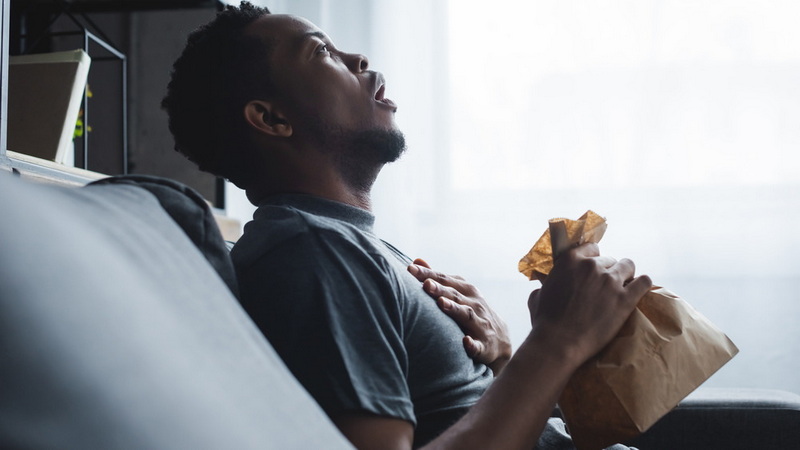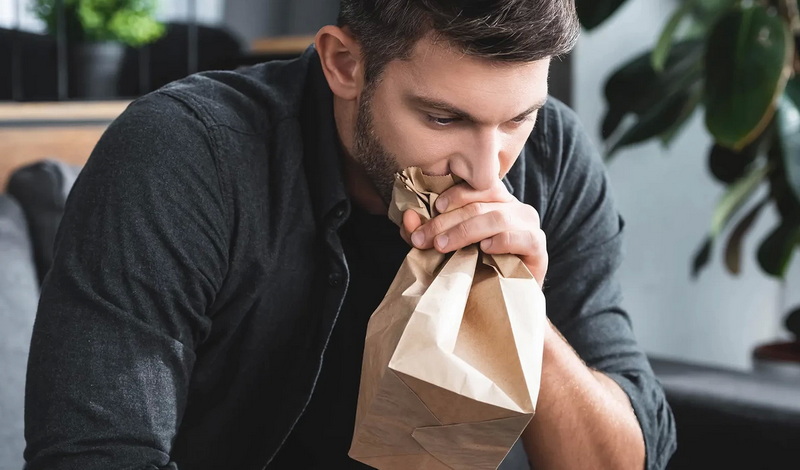Content Menu
● Understanding the Practice of Breathing into a Paper Bag
● The Physiology of Breathing and Hyperventilation
>> Hyperventilation Explained
>> The Role of Carbon Dioxide
● How Breathing into a Paper Bag Works
>> Mechanism of Action
● Effectiveness of Breathing into a Paper Bag
● Risks and Considerations
>> Potential Dangers
● The Psychological Aspect of Breathing Techniques
>> Focus on Breathing
>> Expectation and Suggestion
● Alternative Techniques for Managing Anxiety
● Understanding Panic Attacks
>> ymptoms of Panic Attacks
>> Triggers for Panic Attacks
● Conclusion
● Related Questions
>> 1. What are the symptoms of hyperventilation?
>> 2. Can breathing into a paper bag help everyone?
>> 3. What should I do if someone is hyperventilating?
>> 4. Are there safer alternatives to using a paper bag?
>> 5. When should I seek medical help for hyperventilation?
● Citations:
Understanding the Practice of Breathing into a Paper Bag
Breathing into a paper bag has long been associated with managing anxiety and panic attacks, often depicted in movies and television shows. While it may seem like a simple solution, the physiological mechanisms behind this practice are complex. This article will explore what breathing into a paper bag does, how it works, its effectiveness, and the potential risks involved.

The Physiology of Breathing and Hyperventilation
Hyperventilation Explained
Hyperventilation occurs when an individual breathes at an abnormally rapid rate, leading to an excessive loss of carbon dioxide (CO2) from the body. This can result from various triggers, including anxiety, panic attacks, or physical exertion. When CO2 levels drop too low, the blood's pH balance is disrupted, leading to a condition known as respiratory alkalosis. Symptoms of hyperventilation can include:
- Dizziness
- Tingling sensations in the fingers and toes
- Shortness of breath
- Chest pain
- Confusion
These symptoms can exacerbate feelings of anxiety, creating a vicious cycle that can be difficult to break.
The Role of Carbon Dioxide
Carbon dioxide is often misunderstood as merely a waste product of respiration. However, it plays a critical role in maintaining the body's acid-base balance (pH). When CO2 levels fall too low due to hyperventilation, the blood becomes more alkaline, which can lead to various physiological disturbances. Reintroducing CO2 into the body through techniques like breathing into a paper bag aims to restore this balance.
How Breathing into a Paper Bag Works
Mechanism of Action
When an individual breathes into a paper bag, they exhale CO2 into the bag and then inhale that same air back in. This process allows them to recapture some of the lost CO2, which can help stabilize blood pH levels. The following steps outline how this technique is typically performed:
1. Find a Paper Bag: Use a small paper bag; plastic bags are not safe as they can restrict airflow.
2. Seal the Bag: Hold the open end of the bag around your mouth and nose lightly.
3. Breathe Slowly: Inhale and exhale slowly into the bag for about 6-12 breaths.
4. Take Breaks: After several breaths, remove the bag and take normal breaths for a moment before repeating if necessary.
This method aims to alleviate symptoms associated with hyperventilation by restoring CO2 levels in the bloodstream.
Effectiveness of Breathing into a Paper Bag
The effectiveness of breathing into a paper bag for managing anxiety and panic attacks is debated among healthcare professionals. Some studies suggest that it can be beneficial for certain individuals experiencing hyperventilation due to anxiety. However, there are significant caveats:
- Not Universally Effective: While some people report relief from anxiety symptoms using this technique, it does not work for everyone.
- Potential Risks: For individuals with underlying respiratory conditions (like asthma) or cardiovascular issues, breathing into a paper bag can worsen their condition by further reducing oxygen intake.
Risks and Considerations
Potential Dangers
1. Hypoxia: If an individual is already experiencing low oxygen levels (hypoxemia), rebreathing exhaled air may exacerbate their condition, leading to serious complications.
2. Dependency: Some individuals may become reliant on this technique during anxiety episodes, which could hinder their ability to manage panic attacks without it.
3. Misdiagnosis: It is crucial to ensure that hyperventilation is indeed due to anxiety rather than other medical conditions that might require different interventions.
4. Alternative Techniques: Other methods such as controlled breathing exercises or mindfulness techniques may be safer and more effective for managing anxiety symptoms without the risks associated with paper bags.

The Psychological Aspect of Breathing Techniques
Focus on Breathing
In addition to its physiological effects, breathing into a paper bag provides a psychological focus for individuals experiencing anxiety or panic attacks. The act of focusing on breathing into the bag can serve as a distraction from overwhelming thoughts or feelings associated with panic. This focus can help ground individuals in the present moment and reduce feelings of impending doom.
Expectation and Suggestion
Research indicates that expectation plays a significant role in how effective breathing techniques are perceived to be. When individuals believe that breathing into a paper bag will help them feel better, this belief alone can lead to improvements in their symptoms. This phenomenon highlights the importance of psychological factors in managing anxiety and panic attacks.
Alternative Techniques for Managing Anxiety
While breathing into a paper bag may offer temporary relief for some individuals, there are numerous alternative techniques that can be employed to manage anxiety more effectively:
- Controlled Breathing Exercises: Techniques such as diaphragmatic breathing or box breathing encourage slow and deep breaths without the risks associated with rebreathing exhaled air.
- *Diaphragmatic Breathing*: This technique involves engaging the diaphragm fully while inhaling deeply through the nose and exhaling slowly through pursed lips. It promotes relaxation by increasing oxygen intake and reducing stress levels.
- *Box Breathing*: Also known as square breathing, this method involves inhaling for four counts, holding for four counts, exhaling for four counts, and holding again for four counts before repeating. This structured approach helps regulate breath patterns and calm the mind.
- Mindfulness Meditation: Practicing mindfulness helps individuals focus on their present experiences without judgment, which can significantly reduce feelings of anxiety. Mindfulness encourages awareness of thoughts and feelings while promoting acceptance rather than avoidance.
- Progressive Muscle Relaxation (PMR): This technique involves tensing and relaxing different muscle groups in sequence to promote physical relaxation and reduce tension associated with anxiety. By focusing on physical sensations during PMR, individuals can learn to recognize areas of tension in their bodies and consciously relax them.
- Cognitive Behavioral Therapy (CBT): Engaging in CBT with a trained therapist can provide tools and strategies for managing anxiety effectively over time. CBT focuses on identifying negative thought patterns and replacing them with healthier perspectives while developing coping mechanisms tailored to individual needs.
Understanding Panic Attacks
To better appreciate why techniques like breathing into a paper bag are used during moments of acute distress, it's essential to understand what panic attacks entail:
ymptoms of Panic Attacks
Panic attacks are sudden episodes of intense fear or discomfort that peak within minutes. They often include:
- Heart palpitations
- Sweating
- Trembling or shaking
- Shortness of breath
- Feelings of choking
- Chest pain
- Nausea or abdominal distress
- Dizziness or lightheadedness
- Chills or hot flashes
- Numbness or tingling sensations
- Feelings of unreality or detachment from oneself
These symptoms can be overwhelming and frightening, leading individuals to seek immediate relief through various means—including breathing techniques.
Triggers for Panic Attacks
Panic attacks can be triggered by various factors such as:
- Stressful life events (e.g., job loss, relationship issues)
- Major changes (e.g., moving cities)
- Health concerns (e.g., chronic illness)
- Substance use (e.g., caffeine or recreational drugs)
Understanding these triggers can help individuals develop strategies to manage their stressors effectively before they escalate into panic attacks.
Conclusion
Breathing into a paper bag can serve as a temporary measure for some individuals experiencing hyperventilation during anxiety or panic attacks by helping to restore CO2 levels in the bloodstream. However, its effectiveness varies widely among individuals and poses potential risks for those with certain health conditions. It is essential for anyone considering this technique to consult with healthcare professionals for guidance tailored to their specific circumstances.
Moreover, exploring alternative methods such as controlled breathing exercises, mindfulness meditation, progressive muscle relaxation, and cognitive behavioral therapy may provide safer and more sustainable solutions for managing anxiety over time.

Related Questions
1. What are the symptoms of hyperventilation?
Hyperventilation symptoms include dizziness, tingling in extremities, shortness of breath, chest pain, confusion, and feelings of panic.
2. Can breathing into a paper bag help everyone?
No; while it may help some people during panic attacks caused by hyperventilation, it is not effective or safe for everyone.
3. What should I do if someone is hyperventilating?
Encourage them to breathe slowly and deeply without forcing them to use a paper bag unless you are sure they are experiencing anxiety-related hyperventilation.
4. Are there safer alternatives to using a paper bag?
Yes; controlled breathing techniques or mindfulness practices can be effective alternatives without the risks associated with rebreathing exhaled air.
5. When should I seek medical help for hyperventilation?
Seek medical help if hyperventilation persists beyond 30 minutes or if symptoms worsen despite attempts at self-management.
Citations:
[1] https://www.healthline.com/health/anxiety/breathing-into-a-paper-bag
[2] https://www.reddit.com/r/explainlikeimfive/comments/pvk0zm/eli5_why_does_breathing_into_a_paper_bag/
[3] https://www.uclahealth.org/news/article/breathing-into-a-paper-bag-can-calm-anxiety-attack
[4] https://justmind.org/the-science-behind-paper-bag-breathing-for-anxiety/
[5] https://www.mcgill.ca/oss/article/medical-student-contributors-general-science/why-do-some-people-breathe-bag-when-hyperventilating
[6] https://pubmed.ncbi.nlm.nih.gov/2499228/
[7] https://www.7cups.com/qa-panic-attacks-13/how-do-paper-bags-help-with-panic-attacks-129/
[8] https://www.nytimes.com/2008/05/13/health/13real.html
[9] https://firstaidforlife.org.uk/how-to-help-someone-having-a-panic-attack/
































